12 Family-Friendly Destinations for a Perfect Long Weekend
Long weekends are the perfect opportunity for families to spend quality time together. If you’re looking for destinations that cater to all ages, this list of 12 family-friendly attractions in Kanchanaburi and beyond will inspire your next getaway. With activities suitable for everyone, these spots promise fun, relaxation, and unforgettable memories.
Table of Contents
Choosing the right family vacation destination
Family trips are more than just a break from routine—they’re opportunities to strengthen bonds and create lasting memories. Children learn adaptability and social skills, while adults recharge and enjoy quality time with loved ones. Traveling together builds understanding and fosters deeper connections within the family.
Tips for Choosing Family-Friendly Destinations

When selecting a destination, consider the needs of all age groups—children, teens, adults, and seniors. Look for places with:
- Comprehensive amenities.
- A variety of activities for everyone.
- High safety standards.
Planning the itinerary, travel time, and accommodations near attractions ensures a smoother trip. For families visiting Kanchanaburi, River Kwai Resotel Resort offers a convenient and nature-inspired stay near many top attractions, perfect for relaxation and adventure.
12 Family-Friendly Destinations
Here’s a curated list of family-friendly attractions, each offering unique experiences and activities suitable for all ages:
1. Sai Yok Noi Waterfall
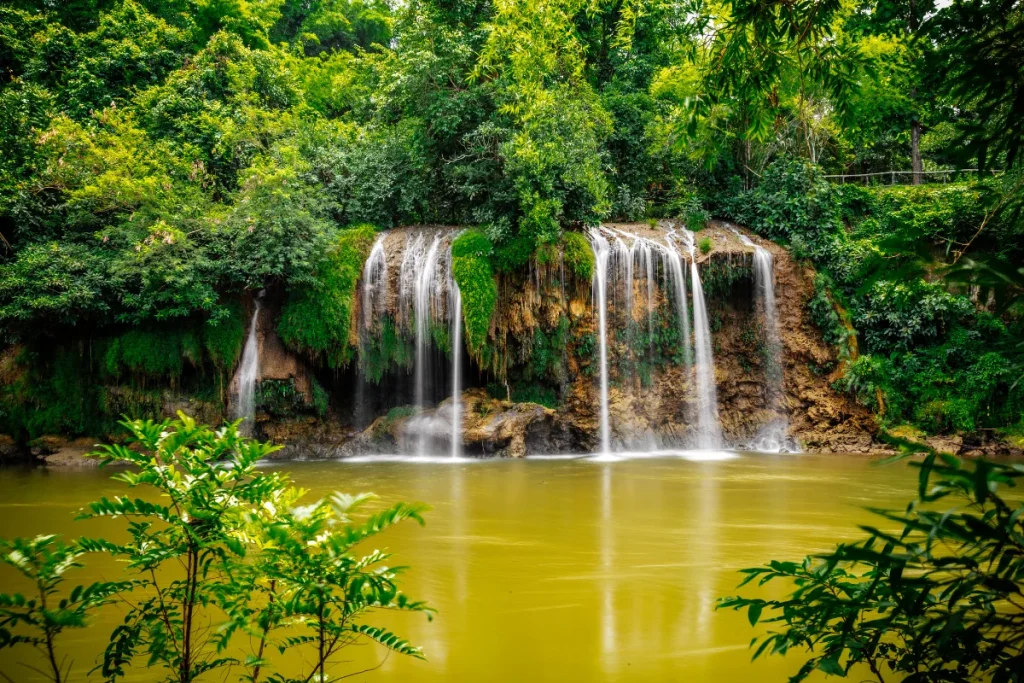
Sai Yok Noi, also known as Khao Chon Waterfall, is a scenic 8-meter waterfall in Sai Yok National Park. Families can enjoy nature walks, admire the views from a suspension bridge, or cool off in the flowing waters. It’s a great spot for picnics and relaxation amidst lush surroundings.
2. Safari Park Open Zoo, Kanchanaburi
Perfect for animal lovers, this open zoo allows families to get up close to various wildlife species. Highlights include giraffe feeding, interactive experiences with animals, and expert-led tours. It’s an educational and entertaining experience, especially for kids.
3. Erawan Waterfall
A must-visit destination, Erawan Waterfall features 7 tiers stretching over 1,500 meters, each with unique beauty. Families can swim in the turquoise pools, explore nature trails, or enjoy a picnic in the serene environment.
4. Hellfire Pass Memorial Museum

This historical site educates visitors about the Death Railway’s history through immersive exhibits. Families can walk along the real Hellfire Pass trail and learn about the struggles of prisoners of war. It’s a meaningful and educational experience for family vacation.
5. Nong Nooch Tropical Botanical Garden
Located in Pattaya, this expansive garden features themed landscapes such as French and Italian gardens, along with life-sized dinosaur statues in the Dinosaur Valley. Families can also enjoy cultural performances and elephant shows, making it an engaging destination for all ages.
6. Sri Ayutthaya Lion Park
This newly opened open zoo spans over 60 acres and offers close encounters with giraffes, lions, and various bird species. The clean and well-maintained park is perfect for families, with interactive areas for feeding animals and plenty of shaded spots for relaxation.
7. Khao Chong Lom
Nestled behind the Khun Dan Prakarn Chon Dam, this lush natural retreat boasts stunning green landscapes and seasonal waterfalls. Its tranquil atmosphere is ideal for relaxation, and it offers plenty of Instagram-worthy spots, making it a favorite among nature-loving families.
8. Khao Ngu Stone Park
This former quarry has been transformed into a serene park featuring a 128-meter-tall Buddha footprint, scenic viewpoints, and tranquil walking trails. It’s an excellent destination for families interested in history and nature.
9. Namtok Jed Sao Noi
This 7-tiered waterfall offers shallow pools perfect for children. Families can swim, picnic, or simply relax in the peaceful surroundings. Campsites are also available for those who want to extend their visit.
10. Hua Hin Beach

A classic family destination, Hua Hin Beach is known for its soft sands, calm waters, and various activities like banana boating, jet skiing, and horseback riding along the shore. With seafood restaurants lining the beach, it’s perfect for a day of fun and relaxation.
11. Khao Yai National Park
Ideal for nature-loving families, Khao Yai National Park offers fresh air, lush forests, and activities like hiking, wildlife spotting, and stargazing. With scenic viewpoints and campsites, it’s a perfect escape from city life.
12. Safari World
This expansive wildlife park in Bangkok combines a drive-through safari and a marine park with animal shows. From feeding giraffes to watching dolphins perform, it’s a delightful destination for families with young children.
Conclusion
These 12 family-friendly destinations offer a wide range of activities, from exploring nature and wildlife to enjoying educational and cultural experiences. Whether your family prefers adventure, relaxation, or learning, there’s something for everyone. Plan wisely to match your family’s preferences, and enjoy a trip filled with joy and treasured memories. 🌟
10 Exciting Water Activities in Kanchanaburi You Shouldn’t Miss
Kanchanaburi is a haven for water activities, thanks to its abundant natural waterways, including the Kwai Yai River, Kwai Noi River, and stunning waterfalls. Whether you’re an adrenaline junkie or seeking a peaceful retreat, these 10 water activities in Kanchanaburi promise fun and unforgettable experiences.
For a complete, activity-packed getaway, consider staying at River Kwai Resotel Resort, a boutique riverside retreat. Designed to immerse you in nature, it features private balconies overlooking lush greenery. With activities like paddleboarding, kayaking, bamboo rafting, and boat tours, it’s a perfect destination for both relaxation and adventure.
Table of Contents
1. Paddleboarding
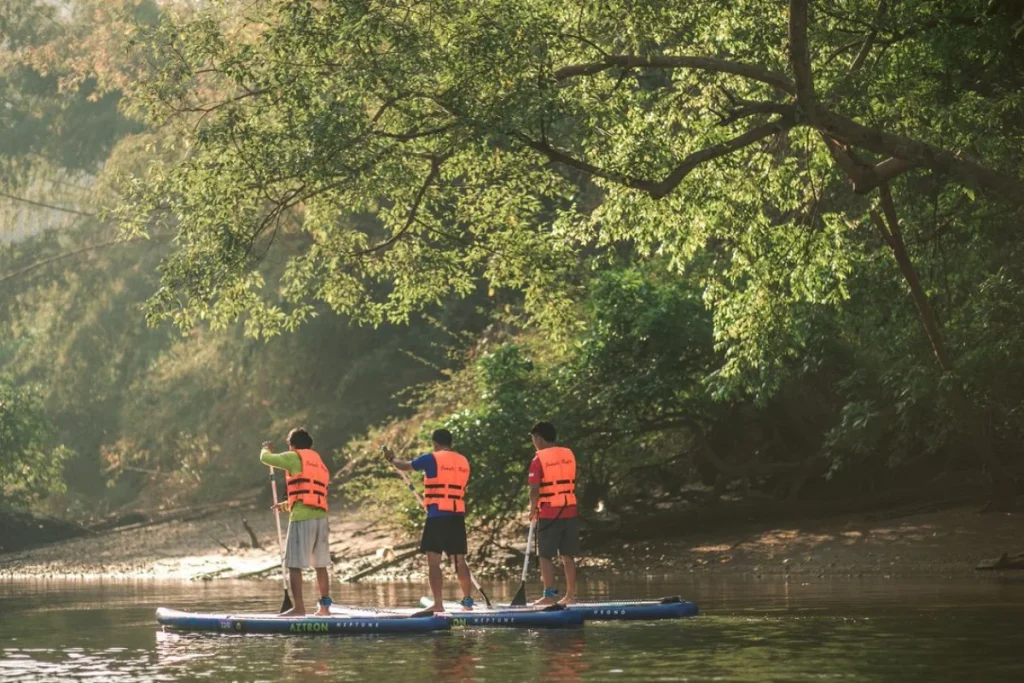
Paddleboarding is a relaxing and increasingly popular activity in Kanchanaburi. The clear waters and breathtaking views of the Kwai River create the perfect setting for beginners and experienced paddlers alike. Equipment rentals and expert lessons are readily available. Plus, it’s a fantastic opportunity to snap stunning photos while soaking in nature’s tranquility.
2. Natural Boat Tours
Explore the beauty of the Kwai River with a scenic boat tour. Drift along the lush, forested banks and listen to fascinating historical stories from local guides. It’s a wonderful way to experience both the natural and cultural richness of the area.
3. Kayaking on the Kwai River
For adventure Activities, kayaking on the Kwai River offers an exhilarating way to connect with nature. Glide through calm waters surrounded by greenery, with options for single or tandem kayaks. Safety gear and professional supervision ensure a safe and enjoyable experience.
4. Traditional Bamboo Rafting
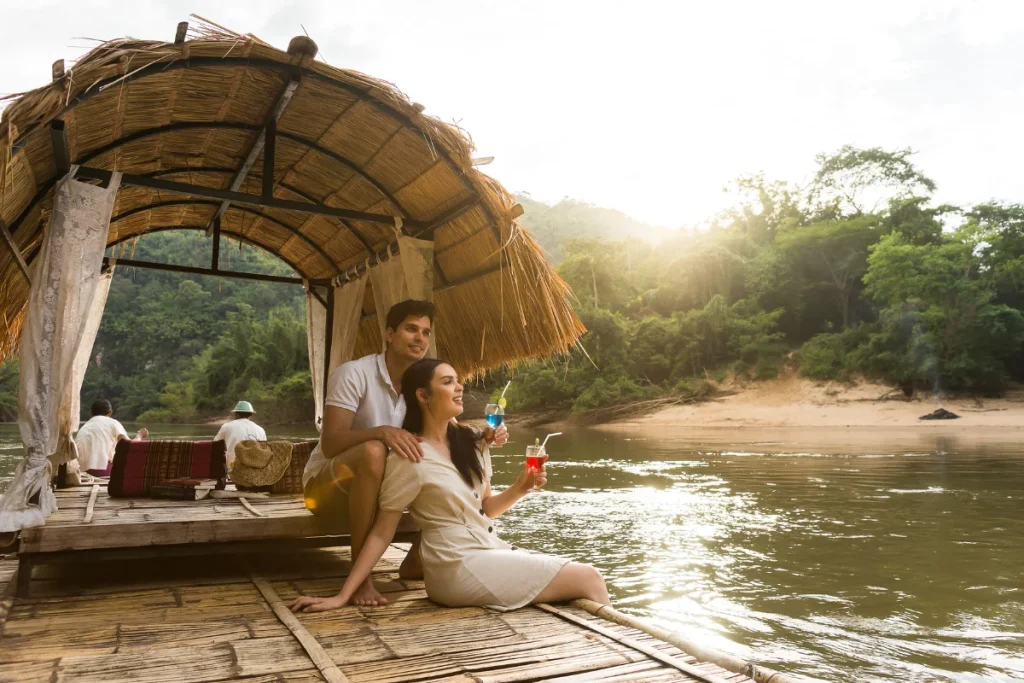
Immerse yourself in the charm of traditional bamboo rafting. Float leisurely along the pristine Kwai River, soaking up scenic mountain and forest views. This peaceful activity is perfect for relaxation while enjoying the cool breeze and tranquil surroundings.
5. Jet Skiing in river kwai
For thrill-seekers, jet skiing on the Kwai River offers an adrenaline-pumping experience. Professional instructors provide guidance and safety equipment, ensuring both excitement and security. Choose from short rides or extended tours for an unforgettable adventure.
6. Swimming at Waterfalls
Kanchanaburi boasts numerous beautiful waterfalls, including Erawan Waterfall, Sai Yok Noi Waterfall, and Huay Mae Khamin Waterfall. These natural attractions offer crystal-clear waters and serene settings, ideal for Swimming and relaxing Many sites also feature picnic spots and camping areas for a full day of fun.
7. Hot Spring Bathing
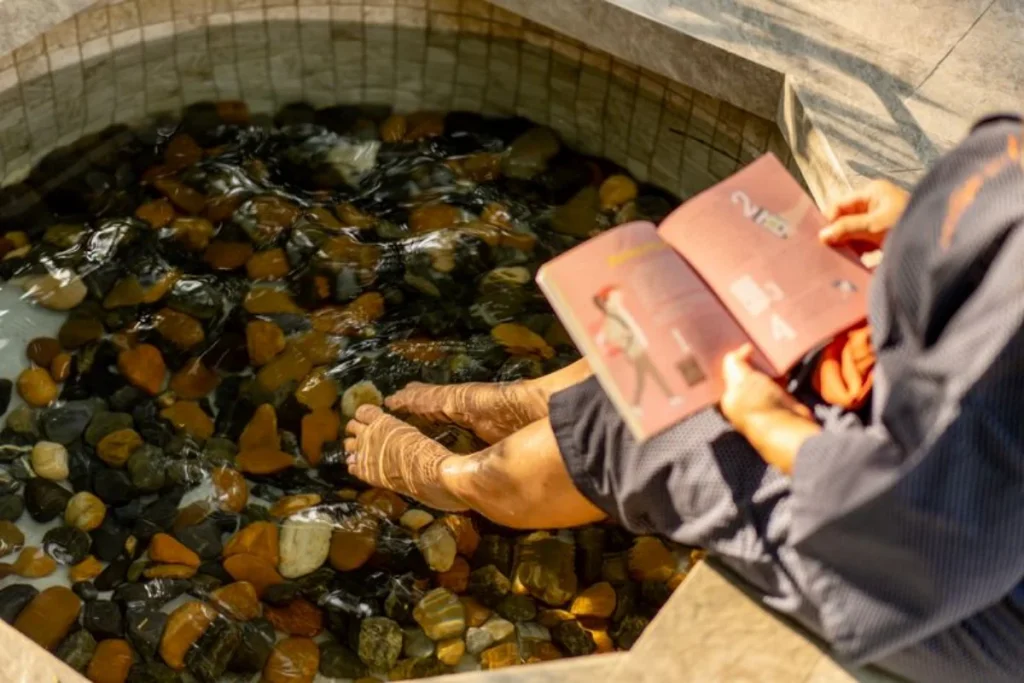
Unwind with a soak in the natural hot springs of Hin Dat Hot Springs. Rich in minerals beneficial for health, the warm waters help alleviate stress and muscle aches. Choose from private or communal pools surrounded by lush greenery for a rejuvenating experience.
8. Tubing
For a laid-back water activity, tubing down the Kwai River is an excellent choice. Float at your own pace in a rubber tube while enjoying the cool waters and scenic views. Tubes of various sizes are available, making this activity suitable for all ages.
9. Pedal Boating
Many riverside accommodations in Kanchanaburi offer pedal boats for guests to enjoy. Paddle leisurely through designated areas, combining fun and exercise. Perfect for families or groups of friends, it’s a delightful way to bond and create lasting memories.
10. Water Parks
Kanchanaburi’s water parks are packed with thrilling rides like giant slides, wave pools, and kid-friendly play areas. With full amenities and safety measures, these parks are perfect for families looking for a day of carefree fun.
Conclusion
Kanchanaburi offers a wide range of water activities suitable for all ages and preferences. Whether you’re seeking adventure or relaxation, there’s something for everyone. Before heading out, check the weather and follow safety guidelines to make your trip both enjoyable and secure. Embrace the fun and let Kanchanaburi’s natural beauty refresh your spirit! 🌊
meeting room
Stargazing Spots for Beginners Start Easily Without Equipment
“Stargazing Spots” is a beloved activity for many, not only because it’s enjoyable, but also because it’s an opportunity to learn something new. If you’re a beginner interested in stargazing but unsure how to get started, this article will guide you through the preparation and recommend some great stargazing spots with clear skies and beautiful surroundings.
How to Prepare for Stargazing
To ensure your stargazing experience goes smoothly, let’s take a look at how to prepare and what essentials to bring along.
1.Choosing the Right Day and Time
Technically, you can stargaze every night, but the winter season is the best time for stargazing because the nights are longer than the days, and you don’t have to worry about storms like in the rainy or hot seasons. Additionally, the winter sky is usually clear with fewer clouds, making it ideal for stargazing.
2.Dressing for the Weather
You can choose your outfit according to the current weather, but if you’re stargazing in winter as recommended, don’t forget to bring a long-sleeved shirt, a jacket, or a scarf to keep warm while you comfortably lie down and enjoy the stars.
3.Basic Equipment to Bring
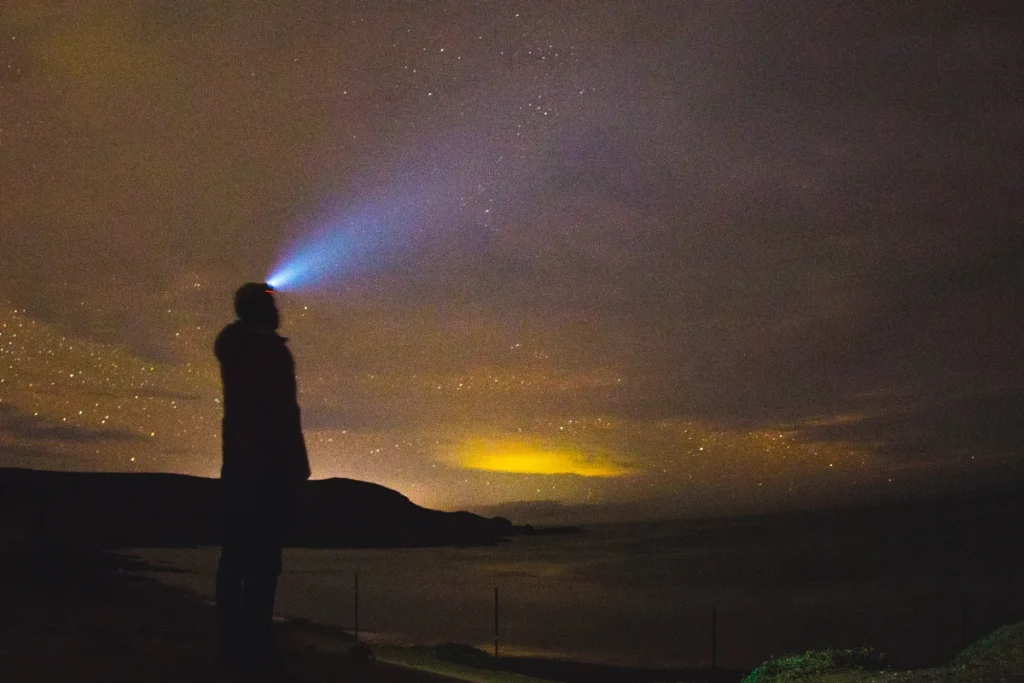
If you’re a beginner without a telescope, don’t worry! Here are some basic tools that will suffice for a good stargazing experience
- Star Map or Stargazing App: These tools help you identify the stars’ positions easily.
- Flashlight: Essential for navigating in the dark and reading the star map.
- Water: Bring enough for yourself and your group to stay hydrated.
Stargazing Tips for Beginners
- Allow your eyes to adjust to the darkness for clearer stargazing. The darker the location, the more stars you’ll see.
- Use a star map or a stargazing app to help you identify stars and constellations, which will make it easier for beginners to find what they’re looking for.
- If you want to find the North Star with the naked eye, remember the direction where the sun sets, which is the west. Face that direction, extend your right arm parallel to the ground, and point your thumb down and your index finger up. The North Star will be above your index finger.
Top 5 Stargazing Spots for Beginners in Thailand
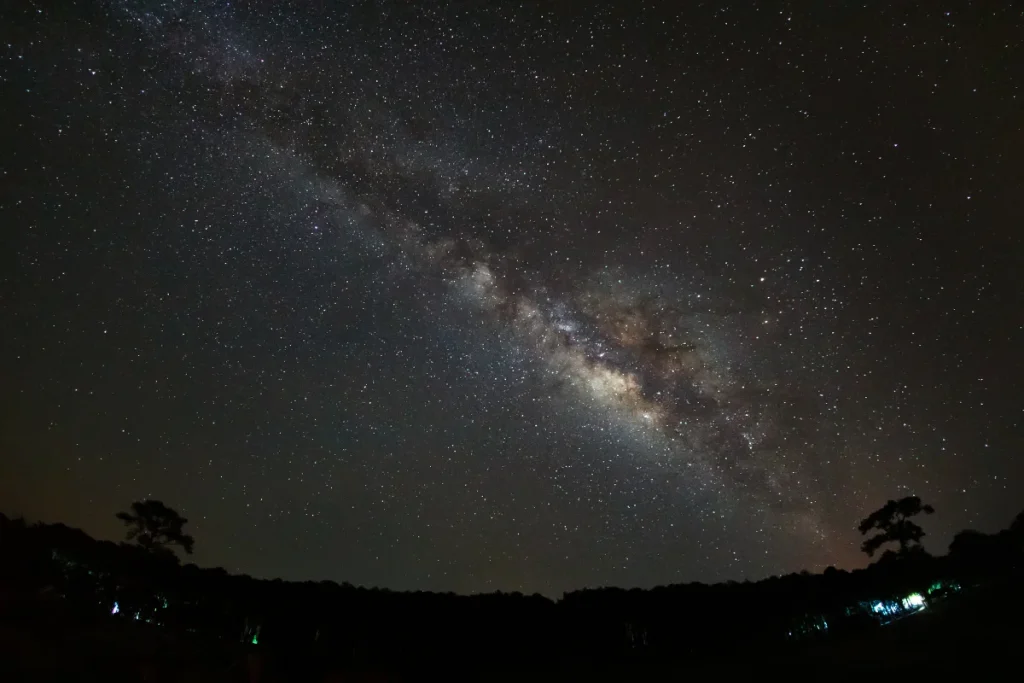
It’s hard to see stars in the city, so choosing a good stargazing spot is crucial. If you’re unsure where to start, here are five popular stargazing spots in Thailand that are perfect for beginners.
1. Noen Chang Suek, Kanchanaburi
Noen Chang Suek, or Pilok Peak, is a mountain about 1,053 meters above sea level, offering stunning panoramic views. While it’s known for its sea of mist in the morning, it’s also a popular stargazing spot at night.
2. Khao Yai National Park, Nakhon Ratchasima
Khao Yai National Park is home to “Khao Rom Viewpoint,” a great place for stargazing. You might even catch astronomical phenomena like the Milky Way, lunar eclipses, or meteor showers here.
3. Phu Hin Rong Kla National Park, Phitsanulok
Phu Hin Rong Kla National Park is known for its “Lan Hin Pum” rock formations, but its camping area is also perfect for stargazing, with open skies that offer clear views of the stars, especially in the winter when the Milky Way is visible.
4. Doi Inthanon National Park, Chiang Mai
Many people can easily imagine how perfect Doi Inthanon is for stargazing, as it’s Thailand’s highest peak with cool weather all year round. It’s also one of the best places in Thailand to witness rare natural phenomena.
5. Khao Luang National Park, Nakhon Si Thammarat
Khao Luang National Park offers 360-degree views of the night sky, allowing you to stargaze all night long in a peaceful and cool setting.
Conclusion
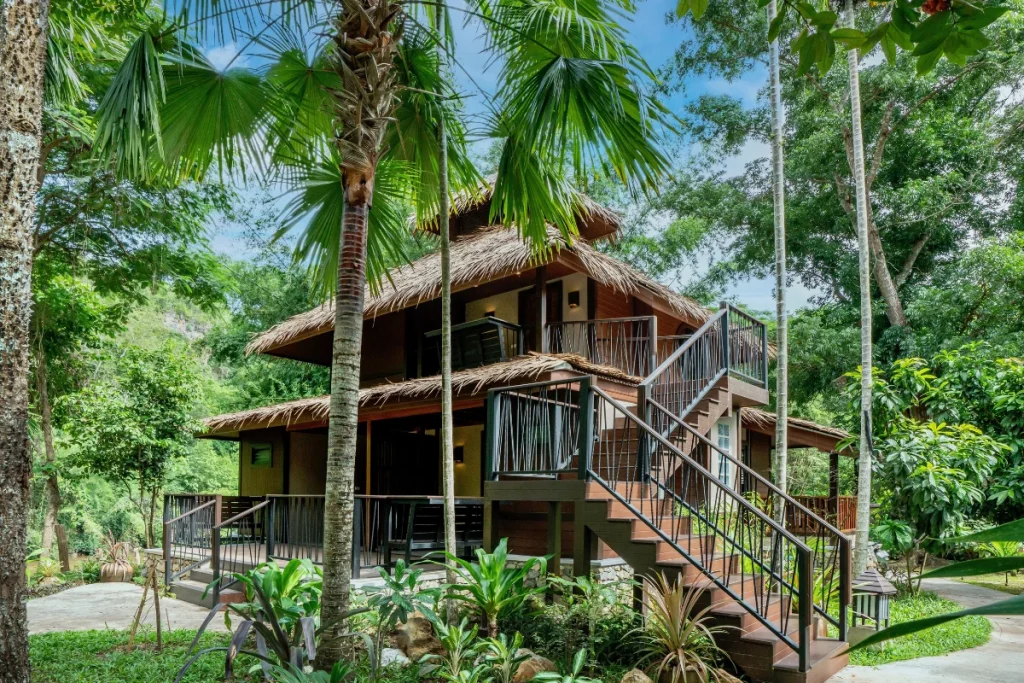
So, how do you feel about these stargazing tips and popular spots in Thailand? Any places that catch your eye? If the five locations mentioned above don’t appeal to you, or if you’d rather avoid hiking to high-altitude spots, another excellent place for stargazing is Kanchanaburi. Known for its beautiful, clear skies, Kanchanaburi is a great stargazing destination.
After your adventures, we recommend staying at the River Kwai Resotel Resort, a nature-integrated resort. Each room comes with a private balcony, where you can enjoy the surrounding beauty and even stargaze from the comfort of your room at night.
Batik Silk The Hidden Gem of Kanchanaburi
When travelers visit Kanchanaburi and look for souvenirs, they are often directed towards gemstones or spice mixes, both well-known local specialties.
However, Kanchanaburi also has another lesser-known treasure, “Batik Silk” which makes for a unique and memorable gift. If you’re searching for a special and distinct souvenir, let us introduce you to the beauty of Kanchanaburi’s Batik Silk.
The History of Batik Silk
The art of creating Batik Silk in Kanchanaburi was initiated by Mr. Tanoodej Koetwisesing, who inherited the knowledge of silk weaving from his relatives. Initially, cotton was woven using traditional methods, but eventually, the craft evolved into weaving silk and integrating Batik painting techniques. After further studies in Batik fabric painting, Mr. Tanoodej established the Batik Silk Craft Center in 1992, passing on the knowledge and creating a hub for local artisans.
The Process of Creating Batik Silk
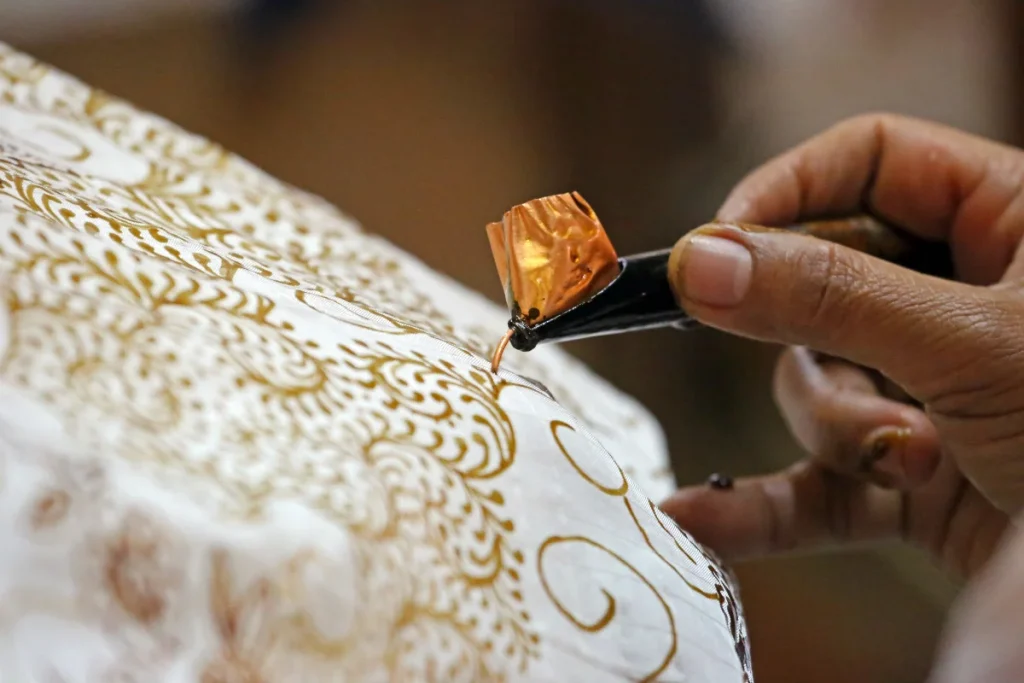
At the Batik Silk Craft Center, the production process is entirely eco-friendly, without the use of machinery or harmful chemicals. Here’s a brief overview of the tools and steps involved in making Batik Silk.
Materials:
- Silk fabric
- Bleaching solution
- Glitter
- Gold-colored pen
- Anti-color-bleed solution
- Laundry detergent
Steps:
- Dyeing the Silk: The silk is dyed in the desired base color.
- Bleaching: The fabric is bleached to remove excess color in areas where the dye hasn’t fully absorbed.
- Designing Patterns: The design is created to match the characteristics of the silk.
- Gold Pen Drawing: Patterns are drawn onto the fabric using a gold-colored pen.
- Painting: The fabric is painted with the desired colors.
- Anti-Color-Bleed Coating: The fabric is treated to prevent the colors from bleeding.
- Washing: The Batik Silk is washed with detergent as the final step.
Unique Patterns and Colors of Kanchanaburi’s Batik Silk
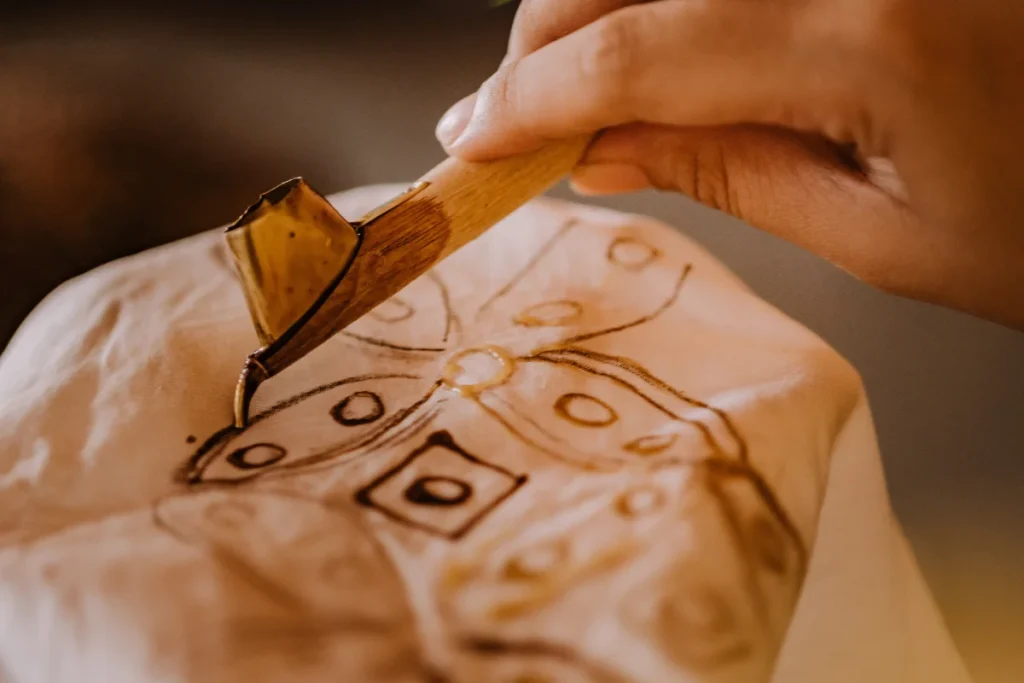
Silk is a treasured cultural heritage of Thailand, reflecting the evolution of traditions and customs over time. When combined with Batik painting, Thai silk becomes even more distinctive. Some of the signature patterns and colors of Kanchanaburi’s Batik Silk include:
- Gold-painted Batik Silk: Featuring intricate designs drawn with glitter.
- Thai-style Batik Silk: Created using both glitter and acrylic paints for added vibrancy.
Incorporating Batik Silk into Daily Life
While Batik Silk is traditionally made in fabric lengths, today it has been transformed into various wearable items and everyday goods, such as clothing and accessories, increasing both its uniqueness and value. This makes Batik Silk an ideal souvenir from Kanchanaburi for those looking to give a one of a kind gift.
Conclusion
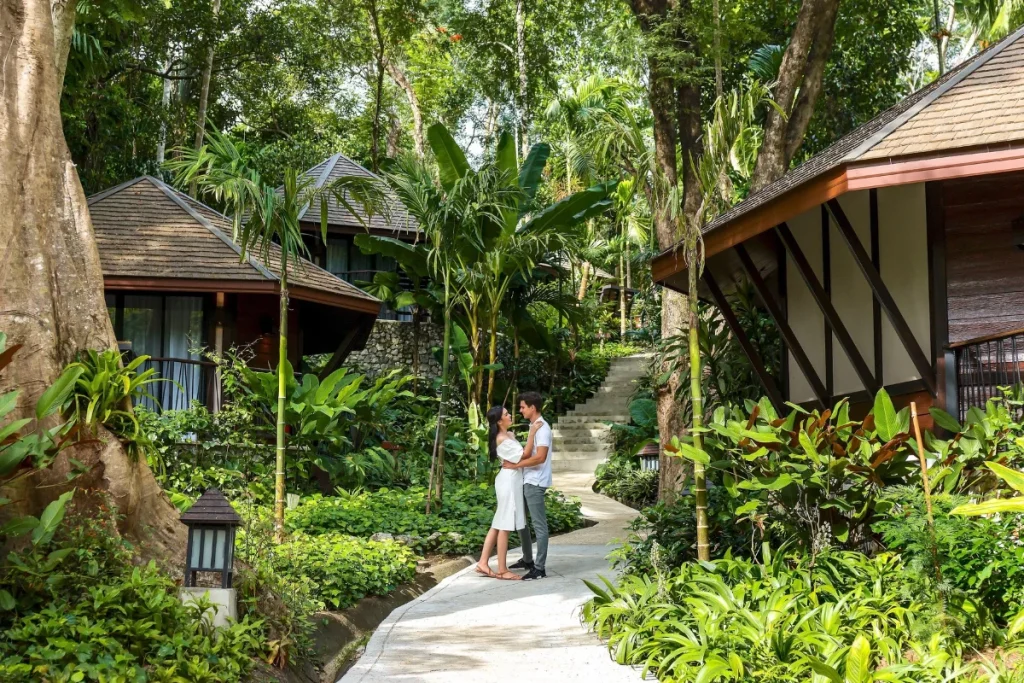
Kanchanaburi’s Batik Silk is a truly unique and exquisite craft that stands apart from other souvenirs. With its intricate, hand-made production process and artistic designs, it’s a perfect choice for anyone seeking something special to take home.
If you’re planning a trip to Kanchanaburi, don’t miss the opportunity to purchase Batik Silk as a meaningful gift.Additionally, if you’re looking for a serene place to stay while in Kanchanaburi, we highly recommend River Kwai Resotel Resort. Located amidst lush nature, it offers the perfect setting for a relaxing getaway.
Kanchanaburi’s Must-See: Song Kwae Skywalk Viewpoint
If you’re looking for a relaxing nature getaway, we highly recommend the Song Kwae Skywalk viewpoint in Kanchanaburi. It’s a great spot for both sightseeing and relaxing, surrounded by lush nature. If you’re planning a trip to Kanchanaburi, this is a must-visit! Trust us, you’ll get tons of stunning photos when you check in here. It’s also super easy to get to, whether you’re driving or using public transportation.
Which river does the Song Kwae Skywalk cross?

The Song Kwae Skywalk in Kanchanaburi is located along the Khwae Yai River in Muang district, near the Kanchanaburi City Pillar Shrine. It used to be a boat landing for the two-colored river tours, but now it’s a popular tourist destination where people come to enjoy the natural scenery. The skywalk offers views of the merging of three rivers, along with impressive architectural sights, making it a spot where many visitors like to spend plenty of time exploring.
Highlight of the Song Kwae Skywalk

The highlight of the Song Kwae Skywalk is the stunning view of the Khwae River from a height of 12 meters above the road, with a length of 150 meters. What makes it special is the glass floor, which is clear yet strong, allowing you to see the river below as you walk, adding a thrilling and exciting element to the experience. Another highlight is that, from the right side of the bridge, you’ll see the majestic Pagoda of Somdet Phra Yannasangwon, while on the left, you’ll witness the merging of three rivers, offering a complete and breathtaking view in one spot—perfect for capturing memorable photos.
Getting to Song Kwae Skywalk:
- By car: From Bangkok, take Phetkasem Road, continue on Sangchuto Road (Route 323), pass the Kanchanaburi Provincial Hall, and head to Khun Paen Pier on Song Kwae Road, just 400 meters from the Kanchanaburi City Pillar Shrine.
- By Bus terminal: Get off at the Kanchanaburi Bus Terminal and head to Khun Paen Pier on Song Kwae Road, about 850 meters from the bus terminal.
Summary of content

Who would have thought that Kanchanaburi would have such a gem like the Song Kwae Skywalk, offering views of three rivers? It’s the perfect spot to relax and enjoy nature all day long. Extend your stay by checking into a riverside resort like River Kwai Resotel, where you can enjoy beautiful river views and a peaceful atmosphere, making your Kanchanaburi trip truly enjoyable. Don’t wait—plan your visit and be ready for an unforgettable experience!

Deluxe Family Quad
Explore the Enchanting Depths of Lawa Cave in Kanchanaburi
Explore the Enchanting Depths of Lawa Cave in Kanchanaburi
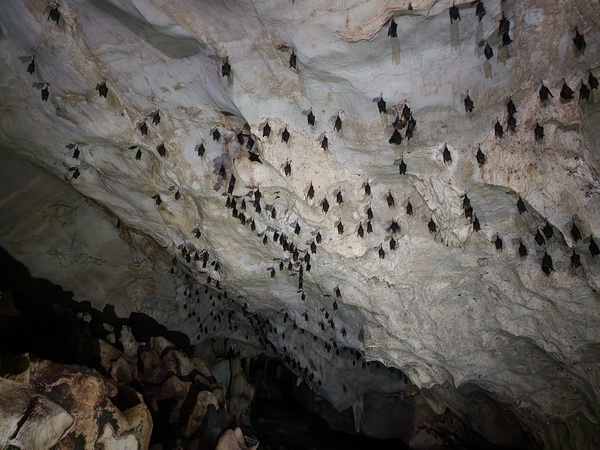
Lawa Cave is a stalactites and stalagmites cave, located in Wang Krachae Subdistrict, Sai Yok District, Kanchanaburi Province. The cave stands as the largest cave in the province, boasting a rich history and stunning natural formations. This 465-meter-long cavern, known as Kaeng Lawa Cave, is a must-visit destination for those exploring the area.
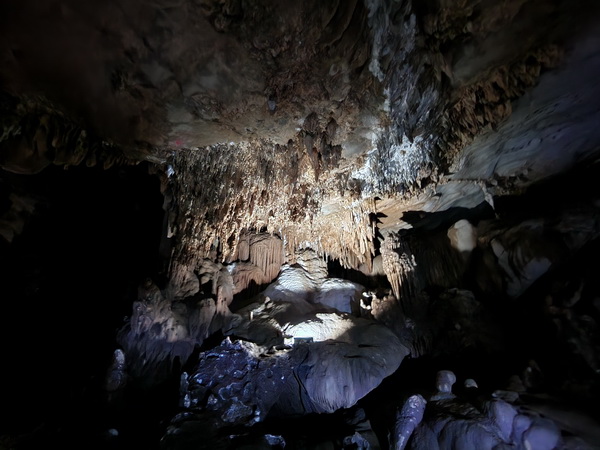
**History and Discovery**
Lawa Cave holds a significant place in the region’s history, as it is one of the first caves in Kanchanaburi to be discovered. Local residents were the first to uncover the cave’s secrets, finding ancient human skeletons within its depths. The discovery sparked interest from the Fine Arts Department, leading to excavations that unearthed ancient tools, pottery, and further evidence of human habitation. It is believed that the cave may have been inhabited by prehistoric humans, dating back over 3,000 years.
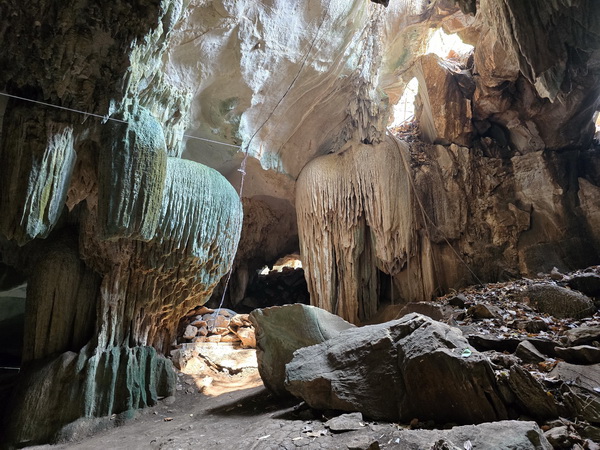
**Natural Formations and Wildlife**
Entering Lawa Cave is like stepping into another world, with water dripping from the ceiling and seeping from the floor, shaping the cave’s intricate formations over millennia. The constant drip of water, carrying traces of organic substances, gradually solidifies into the stalactites and stalagmites that adorn the cave’s interior. These formations, along with ancient pottery and decorations, offer a glimpse into the cave’s ancient past.
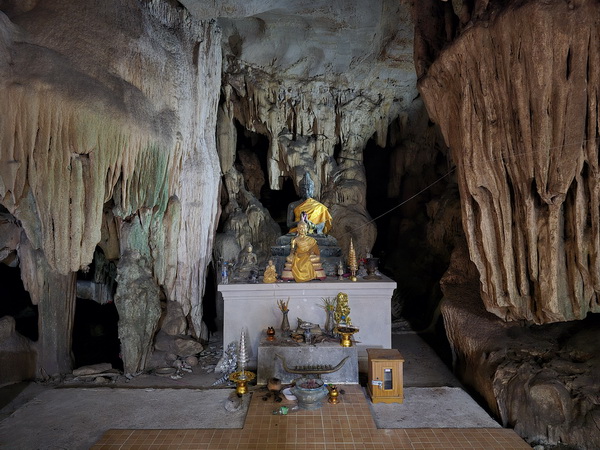
** 5 Chambers of Wonder**
As you venture deeper into the cave, you’ll encounter a series of chambers, each with its own unique features. The Hanuman Room, the first chamber, is located 45 meters from the cave’s entrance and sets the stage for the wonders that lie ahead. The Crocodile Room features a large stalactite resembling a crocodile, adding a touch of whimsy to the cave’s natural beauty. The music chamber delights visitors with its acoustics, producing echoing sounds that reverberate throughout the cave.
Continuing your exploration, you’ll come across the Bat Room, a tall and wide cave hall that was once home to over a thousand bats. While the bats have since moved on, the room retains its awe-inspiring atmosphere. The final chamber, the Hong Man Ban Thom room, is a sight to behold, with stalagmites and stalactites creating a majestic curtain-like effect. The room is adorned with sparkling crystals, giving it the appearance of a palace chamber. Here, you’ll also find a Buddha image enshrined, inviting visitors to pay their respects and reflect on the cave’s spiritual significance.
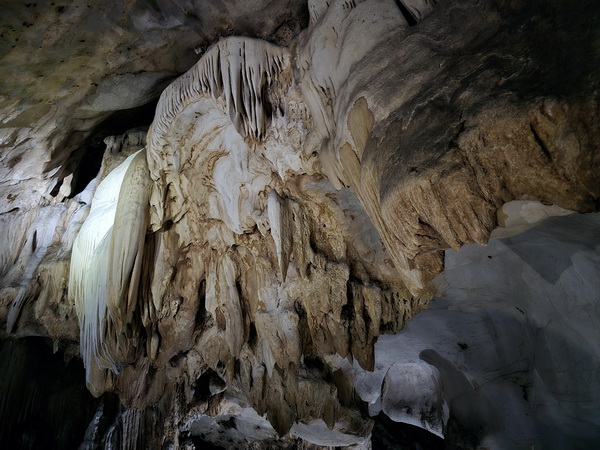
**Wildlife Within Lawa Cave**
Lawa Cave is home to a variety of fascinating creatures that have adapted to its unique environment. Among the inhabitants are the Cave Racer (Elaphe taeniura), a species of snake known for its slender body and swift movements. The cave also harbors Whip Scorpions, known for their distinctive whip-like tails and formidable appearance.
One of the cave’s most notable residents is the Hipposideros armiger, a species of bat that plays a crucial role in the cave’s ecosystem. Additionally, Camel Crickets are commonly found in the cave, adding to its diverse wildlife population. These creatures, along with many others, contribute to the rich biodiversity of Lawa Cave, making it a fascinating destination for wildlife enthusiasts.
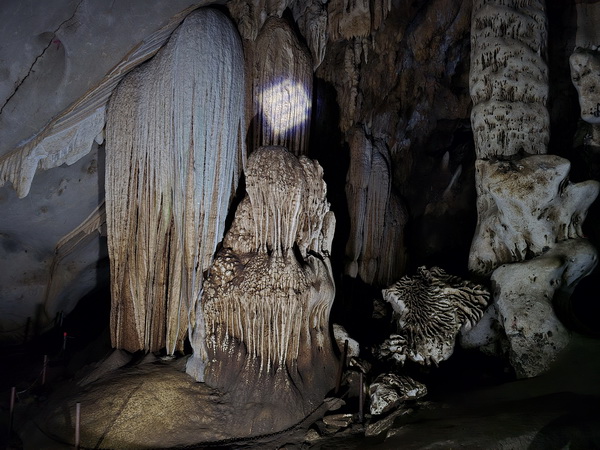
**Getting There and Practical Tips**
Reaching Lawa Cave is an adventure in itself, with several options available. You can choose to travel by boat from Pak Saeng Pier, a scenic 45-minute journey, or by car from Kanchanaburi City (approximately 75 kilometers) or Sai Yok Noi (18 kilometers). After crossing the Ban Kaeng Raboet bridge, a short uphill walk leads you to the cave’s entrance.
When visiting Lawa Cave, it’s advisable to bring a torch to illuminate the cave’s interior, as some areas can be quite dark. While a guide is recommended for a richer experience, you can also explore the cave independently. Lawa Cave offers a captivating blend of natural beauty, history, and adventure, making it a must-visit destination for all travelers exploring Kanchanaburi’s hidden gems.
Please note that there is a steep staircase of 114 steps that must be climbed to reach the cave entrance.
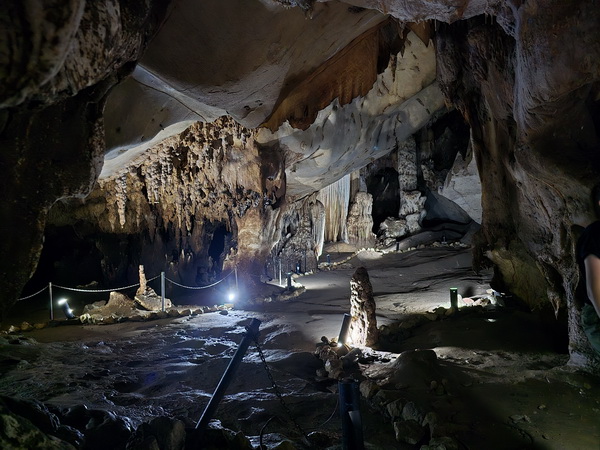
Experience Riverside Bliss at River Kwai Resotel, the perfect accommodation near Lawa Cave
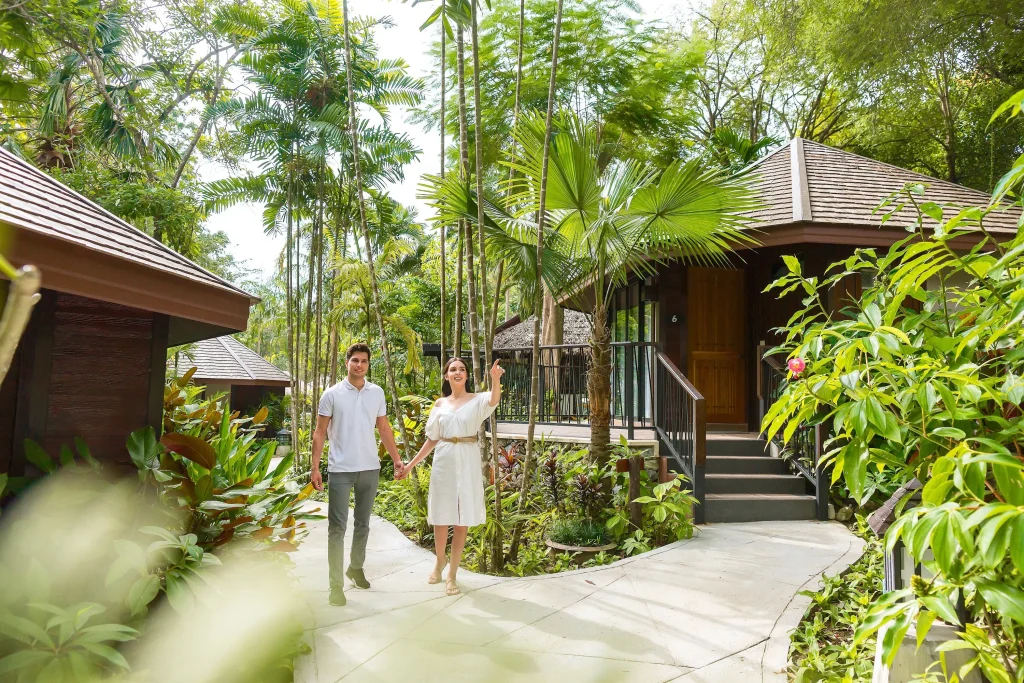
Located just a stone’s throw away from the enchanting Lawa Cave in Kanchanaburi, River Kwai Resotel offers a tranquil escape amidst the natural beauty of the region. Situated along the scenic Kwai Noi River, this riverside botanical resort provides the perfect blend of luxury and serenity, making it an ideal choice for travelers exploring the wonders of Lawa Cave.
Accommodation
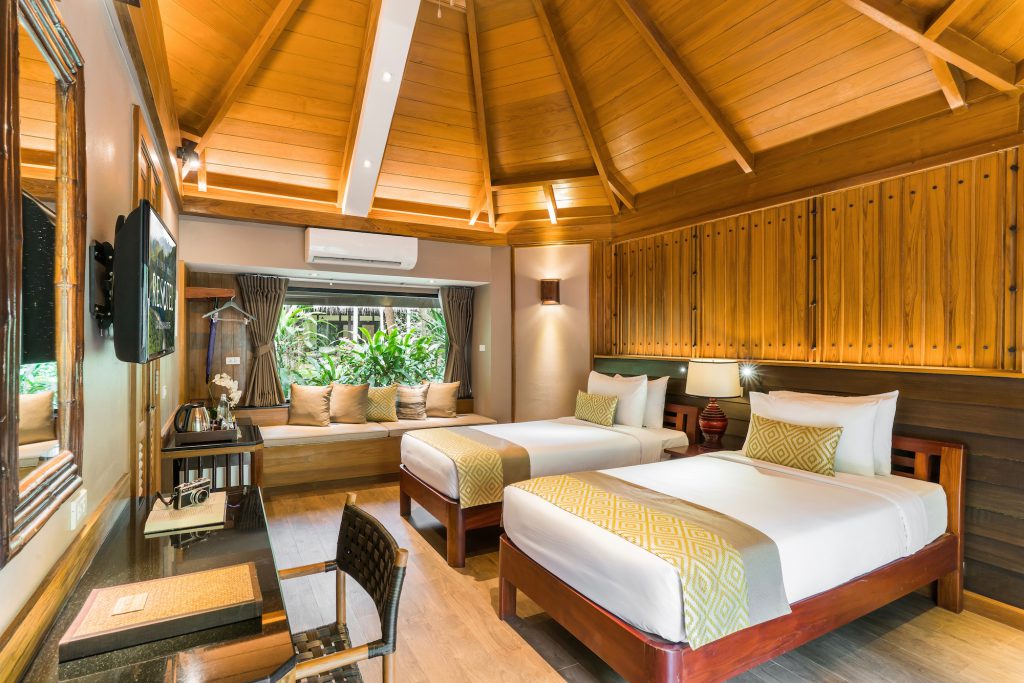
River Kwai Resotel features a range of accommodation options, from cozy rooms to spacious bungalows, each designed to provide utmost comfort and relaxation. The resort’s rooms are tastefully furnished and offer breathtaking views of the river or lush gardens, allowing guests to immerse themselves in the beauty of their surroundings.
Facilities and Activities
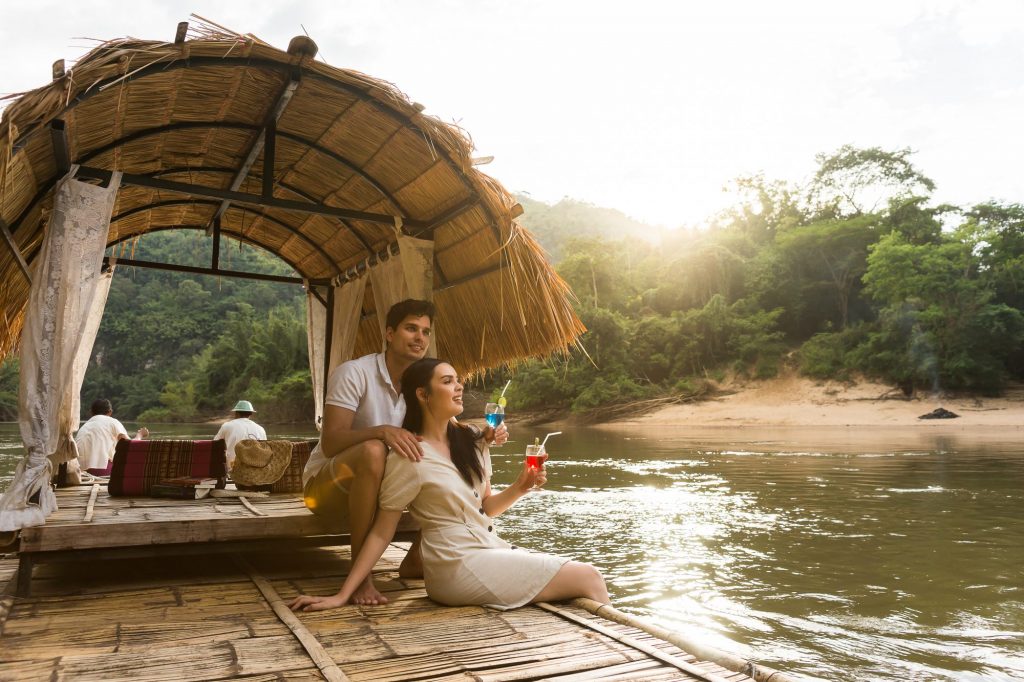
Guests at River Kwai Resotel can indulge in a variety of activities, from relaxing by the river or exploring the resort’s botanical gardens to more adventurous pursuits such as kayaking or bamboo rafting along the river. The resort also offers guided tours to Lawa Cave and other nearby attractions, allowing guests to discover the rich history and natural wonders of the region.
Dining

The resort’s restaurant serves delectable Thai and international cuisine, made with fresh, locally sourced ingredients. Guests can enjoy their meals overlooking the river, creating a dining experience that is as memorable as it is delicious.

Relaxation and Wellness For those seeking relaxation and rejuvenation, River Kwai Resotel offers a range of wellness services, including traditional Thai massages and spa treatments. These services are designed to help guests unwind and recharge, leaving them feeling refreshed and revitalized.
Deluxe Family with Bunk Beds
Superior Plus
Rare Palm at Palmatum of River Kwai at River Kwai Resotel Riverside Resort in Saiyok, Kanchanaburi

1. Tahina spectabilis
Scientific Name: Tahina spectabilis
Common Name: –
Characteristics:
Tahina spectabilis, often referred to as the “Queen of the Forest,” is a remarkable palm tree species native to a specific region in northwestern Madagascar. It holds the title of being the largest palm tree in the world and is renowned not only for its enormous size but also for its extreme rarity in the plant kingdom.

Found exclusively in the rugged and remote areas of Madagascar, this palm species has become a botanical wonder. The sheer size of Tahina spectabilis sets it apart from other palms. These majestic trees can grow up to an astonishing 18 meters (about 59 feet) in height. Their leaves are equally impressive, measuring up to 5 meters (approximately 16.5 feet) in length. The striking appearance of these towering palms against the backdrop of Madagascar’s unique landscape makes them a sight to behold.
One of the most astonishing aspects of Tahina spectabilis is its limited distribution in the wild. It is estimated that only a minuscule population of 90 to 100 individuals of this palm species remains in its natural habitat. This extreme rarity has raised concerns among conservationists and plant enthusiasts alike, as the survival of Tahina spectabilis is now at risk due to habitat destruction and other threats.



Efforts have been made to protect and conserve the remaining population of Tahina spectabilis, including the establishment of protected areas and initiatives to raise awareness about its endangered status. Researchers and conservationists continue to study this magnificent palm species, hoping to secure its future in the unique ecosystems of Madagascar.


In summary, Tahina spectabilis is an awe-inspiring palm tree species, not only for its extraordinary size but also for its exceptional rarity, found only in a small region of Madagascar. Its towering stature and limited population make it a symbol of both natural beauty and the importance of conservation efforts to protect Earth’s unique and endangered flora.
2. Pelagodoxa Henryana (Henry Palm)
Scientific Name: Pelagodoxa henryana Becc.
Common Name: Henry Palm



Characteristics:
- Type: The Henry Palm is a solitary palm tree, meaning it grows as a single stem without clustering.
- Height: This palm tree can reach impressive heights, with some individuals towering up to 8 meters (about 26 feet). However, it is worth noting that the most aesthetically pleasing height for this palm tree is typically in the range of 1 to 3 meters (approximately 3 to 10 feet). At these heights, the palm exhibits a more graceful and visually appealing appearance.
- Trunk: The central diameter of the trunk typically measures around 15 centimeters (about 6 inches).
- Leaves: The Henry Palm features single leaves with stiff leaflets. These leaves are sizable, with a width of about 1 meter (approximately 3 feet) and a length of up to 2 meters (around 6.5 feet). The leaf tips are bifid, and the undersides of the leaves have a white coloration. The leaf stalk, or petiole, can extend to 50 centimeters (about 20 inches) in length.
- Inflorescence: The palm produces perfect flowers that emerge among the leaf sheaths. The inflorescence, where the flowers are clustered, can reach a length of up to 50 centimeters (approximately 20 inches).
- Fruit: The fruit of the Henry Palm is an aggregate fruit that can grow to a size of up to 6 centimeters (around 2.5 inches). When the fruit ripens, it develops a tough, scaly exterior that resembles cracked wood. These mature fruits take on a brown coloration.
- Soil: The palm thrives in rich and fertile soil.
- Sunlight: It prefers partial shade, indicating that it grows best when it receives dappled sunlight rather than full, direct sun.
- Propagation: To propagate the Henry Palm, seeds are used. However, it’s essential to note that germination from seeds can be a lengthy process, taking anywhere from 6 to 8 months for the seeds to sprout.
- Usage and Other Information: When cultivating the Henry Palm, it is advisable to plant it in areas where strong winds are not prevalent. This precaution helps prevent the leaves from breaking, ensuring the palm’s aesthetic appeal remains intact.



In summary, the Henry Palm, scientifically known as Pelagodoxa henryana, is a striking and unique palm tree species known for its impressive height and attractive foliage. It is a solitary palm that prefers partial shade, rich soil, and protection from strong winds. While it may reach heights of up to 8 meters, it is often most admired when it stands between 1 to 3 meters tall, displaying its elegant beauty. Propagation is done through seeds, but patience is required due to the lengthy germination process.
3. Pholidocarpus macrocarpus
Pholidocarpus macrocarpus, commonly known as “กะเปา” in Thai, with additional information about its habitat, distribution, and physical characteristics:

Habitat and Distribution:
Pholidocarpus macrocarpus is primarily found in the inland lowland peat forests of Malaysia and Thailand. Its habitat consists of swampy forested areas, and it thrives at altitudes up to 500 meters. This palm species is endemic to Peninsular Malaysia and Peninsular Thailand, meaning it is exclusively found in these regions.
Description:
- Size: Pholidocarpus macrocarpus is a striking palm tree that can grow to impressive heights, reaching between 30 to 40 meters (approximately 98 to 131 feet). The palm typically forms a single tall trunk.
- Leaves: Its leaves are palmate, resembling a large fan, and can reach a diameter of approximately 2 meters (around 6.5 feet). Leaf segmentation starts either at the center of the leaf or about one-third of the way to the leaf stalk. The petiole, which connects the leaf to the trunk, measures 2.5-3 meters in length and is armed with sharp thorns.
- Inflorescence: The inflorescence, or spadix, emerges at the axil of the petiole.
- Fruit: Pholidocarpus macrocarpus produces oval-shaped fruits that are 8-10 cm in diameter. These fruits have a corky texture with a knurled or warty surface and a flesh coloration that is orange when ripe.
This palm tree forms a crown composed of 40 to 50 leaves. The leaf sheaths dissolve into a fibrous mesh, displaying a reddish-brown coloration, with an apical extension of up to 40 cm in the form of a ligule. The petiole, dark green and glossy on the outer side, features two longitudinal stripes on the inner side and is armed with straight spines that range from 4 to 7 cm in length, with the longest spines near the base and shorter ones towards the upper end.


The leaf blades initially appear tidy but may become untidy with age. They can grow to an impressive 2 meters in diameter and are divided into 12 to 14 groups of segments. Each segment group is further divided into single-folded segments, with their tips varying from stiff to eventually drooping.
In terms of its reproductive structure, Pholidocarpus macrocarpus has an inflorescence with a peduncle and rachis of approximately equal length, measuring 0.8 to 1 meter. It features five to seven first-order branches, with numerous rachillae, each ranging from 15 to 25 cm in length.
The fruit of this palm species is distinctive, measuring 10-12 cm in diameter, with a corky and warty surface, and it turns brown when mature.


In summary, Pholidocarpus macrocarpus, or “กะเปา,” is a magnificent palm tree that can reach towering heights. It is native to the swampy peat forests of Peninsular Malaysia and Peninsular Thailand. This palm is characterized by its large, segmented leaves, long petioles with thorns, and unique, corky-textured, orange-colored fruits. Its grandeur makes it a noteworthy and valuable part of these tropical lowland ecosystems.
4. Wallichia disticha T. Anderson
Plant Name: The plant known as “ปาล์มนเรศวร” in Thai, with its scientific name as Wallichia disticha T. Anderson, belongs to the palm family (PALMAE).


Characteristics:
- Growth Type: Wallichia disticha is a solitary palm tree, meaning it grows as a single trunk without branching. It can reach a height of 5-8 meters (approximately 16-26 feet).
- Trunk Diameter: The central diameter of its trunk typically measures between 20-30 centimeters (about 8-12 inches).
- Flowering: What makes this palm particularly unique is that it flowers only once in its lifetime, after which it dies. This is a distinctive characteristic not found in most palm species in Thailand.
- Leaf Structure: The leaves of Wallichia disticha have an interesting appearance. They are arranged alternately on two opposite sides of the trunk, resembling the shape of a hand fan. The tips of the leaflets are toothed, akin to the edges of an animal’s bite.
- Inflorescence: This palm produces male and female flowers on the same inflorescence, which emerges at the tip of the trunk. The inflorescence is quite remarkable, with densely packed branches, and it can be as long as 1.5-2 meters.
- Fruits: The fruit of Wallichia disticha is small, measuring around 8-10 cm in diameter. It has a corky, warty surface and turns brown when it ripens, with orange-colored flesh.


Habitat and Origin:
This palm species is primarily found in Thailand, specifically within the protected wildlife sanctuary of Tung Yai Naresuan Wildlife Sanctuary in Kanchanaburi Province. It grows in limestone hill forests at elevations ranging from 500 to 800 meters above sea level. Outside Thailand, it is also found in Myanmar.


Conservation Status:
Wallichia disticha is considered a rare and endangered plant due to habitat destruction caused by human activities. Preservation efforts and environmental conservation are crucial to ensure the survival of this species in its natural habitat for future generations.
5. Talang Queen Palm / White Elephant Palm
The remarkable Talang Queen Palm, scientifically known as Kerriodosa elegans Dransfield:

Discovery and Uniqueness:
The Talang Queen Palm is truly a botanical marvel, as it holds the distinction of being the sole representative of its genus and species globally. Its origins can be traced back to Phuket Province, Thailand, where it was initially discovered in 1929 AD (Buddhist Era 2472). However, it wasn’t until 1983 AD (Buddhist Era 2526) that it was officially classified and given the scientific name Kerriodosa elegans Dransfield. The genus name, Kerriodosa, pays homage to Dr. A.F.G. Kerr, a renowned botanist who made significant contributions to the study of Thailand’s plant diversity.
Endemic Rarity:
This palm species is exceptionally rare and unique as it is found exclusively within the borders of Thailand. Unlike many other plant species with close relatives in various parts of the world, the Talang Queen Palm has no known botanical relatives outside of Thailand. Its exclusivity to Thailand makes it a national and global treasure in the realm of botany.
Botanical Characteristics:
- Solitary Trunk: The Talang Queen Palm typically grows as a solitary trunk without any offshoots. Its height typically ranges from 3 to 4 meters, giving it a compact and elegant appearance.
- Distinctive Leaf Stalk: One of its most distinctive features is its leaf stalk, which is round, glossy, and black in color. These leaf stalks can grow to be quite long, ranging from 2 to 3 meters.
- Circular Leaves: The leaves of this palm are strikingly circular, with a center diameter that can measure between 1.5 to 2 meters. They are adorned with finely serrated leaflets that create an intricate and beautiful pattern along the leaf edges.
- Leaf Coloration: The upper side of the leaves is characterized by a delicate shade of green, while the lower side gleams with a silvery sheen, adding to its aesthetic appeal.
- Fruit Clusters: The Talang Queen Palm produces small clusters of fruit near the base of its leaf stalks. These clusters are approximately the size of lychee fruits and are a bright yellow color.
Dioecious Nature:
One of its unique biological aspects is its dioecious nature. This means that individual trees are either male or female, and their flowers do not bloom simultaneously. This reproductive strategy enhances cross-pollination and genetic diversity among the population.
Local and Common Names:
Locally, this palm is known by several names in different dialects, including “ปาล์มเจ้าเมืองถลาง” (Talang Queen Palm), “ปาล์มหลังขาว” (White Leg Palm), “ทังหลังขาว” (Tung Leg Palm), and “ชิงหลังขาว” (Ching Leg Palm) in the southern dialect. It also goes by the names “White Elephant Palm” and “King Thai Palm.”
Conservation and Protection:
Given its rarity and unique status, the conservation of the Talang Queen Palm is of paramount importance. Preserving its natural habitat and ensuring its continued existence is not only a matter of botanical significance but also a testament to Thailand’s rich biodiversity. Efforts to protect this palm and its environment are crucial to safeguard this botanical treasure for future generations to appreciate and study.
The Talang Queen Palm stands as a symbol of Thailand’s rich plant diversity and and as a botanical marvel, representing a unique and precious part of Thailand’s natural heritage reflecting the importance of preserving unique and endangered species in the face of environmental challenges.
คู่มือเที่ยวกาญจนบุรี พร้อมแนะนำที่เที่ยว สำหรับคนไปกาญจน์ครั้งแรก!

อยากไปเที่ยวกาญจนบุรีแต่เป็นครั้งแรก หลายคนอาจกังวลเพราะไม่รู้ว่าต้องเดินทางไปอย่างไร ไปถึงแล้วควรไปเช็กอินสถานที่ท่องเที่ยวใดและมีกิจกรรมไหนน่าทำ วันนี้เราจะพามาเปิดคู่มือเที่ยวกาญจน์ครั้งแรก เริ่มต้นตั้งแต่การแนะนำจังหวัด วิธีการเดินทาง สถานที่ท่องเที่ยวที่น่าอัดแน่นไปด้วยกิจกรรม พร้อมลุยแล้ว มาเติมความสุขสนุกสนานกันได้เลย!
ชวนรู้จัก! ประวัติของจังหวัดกาญจนบุรี
กาญจนบุรีเป็นอีกจังหวัดหนึ่งที่น่าไปเยือนสักครั้ง เพราะมีทั้งที่เที่ยวธรรมชาติอันสวยงาม และประวัติศาสตร์ที่สำคัญทั้งของไทย โดยมีการค้นพบเครื่องมือหินที่ย้อนเรื่องราวในอดีตได้ถึงยุคก่อนประวัติศาสตร์ รวมถึงร่องรอยของเหตุการณ์ช่วงสงครามโลกครั้งที่ 2 อันเด่นชัด

หากมองในมุมภูมิศาสตร์ กาญจน์ถือเป็นจังหวัดที่ใหญ่ที่สุดอันดับ 3 ของไทย พื้นที่ส่วนใหญ่เป็นภูเขาสูงและป่าไม้ แล้วกาญจนบุรี ติด กับ จังหวัด อะไร? จังหวัดกาญจนบุรีอยู่ติดกับจังหวัดสุพรรณบุรี ตาก อุทัยธานี ราชบุรี นครปฐมและทางตะวันตกจรดกับประเทศพม่า ส่วนการเดินทางมาเที่ยว กาญจนบุรีก็ไม่ใช่เรื่องยาก จะมีวิธีใดบ้าง มาดูกันต่อเลย
วิธีการเดินทางไปกาญจนบุรี ไม่ยากอย่างที่คิด
กรุงเทพ กาญจนบุรี ระยะทางจะแบ่งได้ 2 เส้นทางคือ เส้นขาออกจากทางพุทธมณฑลจะมีระยะทาง 129 กิโลเมตรและเส้นขาออกจากทางบางบัวทองจะมีระยะทาง 155 กิโลเมตร
• การเดินทางโดยรถยนต์ส่วนตัว
การเดินทางไปกาญจนบุรีสามารถไปได้ 2 เส้นทาง คือ 1. เส้นทางกรุงเทพฯ – พุทธมณฑล – นครปฐม – บ้านโป่ง – กาญจนบุรี 2. เส้นทางกรุงเทพฯ – บางบัวทอง – บางเลน – กำแพงแสน – กาญจนบุรี
• เดินทางโดยรถไฟ
สำหรับรถไฟขบวนธรรมดา สามารถขึ้นรถไฟจากสถานีบางกอกน้อย โดยจะมีรอบรถวันละ 2 เที่ยวในการ เดินทาง ไป กาญจนบุรี คือ รอบเช้าเวลา 7:45 น. และ 13:55 น. ส่วนรถไฟนำเที่ยวขบวนพิเศษจะมีเฉพาะวันเสาร์-อาทิตย์ และวันหยุดนักขัตฤกษ์ โดยขึ้นรถไฟจากสถานีหัวลำโพง
วางแผนที่เที่ยวกาญจนบุรี 2566 ไปกับ 20 ที่เที่ยวยอดฮิตที่ทุกคนต้องไป!
พร้อมออกเดินทางแล้ว มาดูกันเลยว่าสถานที่ยอดนิยมประจำปีที่ใครไปกาญจน์ต้องไม่พลาดมีพิกัดไหนบ้าง บอกเลยว่ามีความหลากหลาย จะไปเที่ยวกับเพื่อน ครอบครัวหรือคนรู้ใจก็ต้องถูกใจอย่างแน่นอน
1. น้ำตกเอราวัณ

“น้ำตกเอราวัณ น้ำตกสีเขียว ใส สะอาด ที่ไหลลงมาจากก้อนหินขนาดใหญ่ จนเกิดเป็นม่านน้ำตกที่สวยงาม”
2. น้ำพุร้อนหินดาด

“น้ำพุร้อนหินดาด ชวนมาอาบน้ำแร่ ออนเซ็นของเมืองไทย”
3. จุดชมวิวป้อมปี่

“จุดชมวิวป้อมปี่ เป็นจุดชมวิวที่อยู่ริมอ่างเก็บน้ำ ที่เหมาะแก่การดูดาวช่วงค่ำคืน”
4. ช่องเขาขาด

“ช่องเขาขาด เรียกอีกชื่อว่า ช่องไฟนรก อันเป็นส่วนหนึ่งของเส้นทางรถไฟมรณะ”
5. ถ้ำกระแซ

“ถ้ำกระแซ ทางรถไฟสายมรณะหนึ่งในโลเคชันถ่ายรูปสุดหวาดเสียว”
6. วัดจมน้ำ สังขละบุรี

“วัดจมน้ำสังลระบุรี เป็นที่ท่องเที่ยว Unseen ของประเทศไทยซึ่งมีความน่าสนใจตรงที่ซากโบราณต่าง ๆ จมอยู่ใต้น้ำ”
7. สะพานมอญ

“สะพานมอญ เป็นสะพานไม้ที่ยาวที่สุดในประเทศไทยมีความยาว 850 เมตร และเป็นสะพานไม้ยาวเป็นอันดับ 2 โลกเป็นหนึ่งในลิสต์ที่เที่ยว กาญจนบุรีที่ต้องมาให้ได้”
8. ทางรถไฟสายมรณะ

“ทางรถไฟสายมรณะ สร้างขึ้นสมัยสงครามโลกครั้งที่ 2 พร้อมมีเรื่องราวประวัติศาสตร์ที่น่าสะเทือนใจ ให้คนรุ่นหลังไม่ลืมเลือน”
9. วอนแดซอง

“วอนแดซอง คาแฟที่ตกแต่งสไตล์เกาหลีย้อนยุค บรรยากาศภายนอกราวกับเกาะเชจู ใครอยากลองแต่งชุดฮันบกพร้อมถ่ายรูปสวย ๆ ต้องไม่พลาด”
10. ซาฟารี ปาร์คแอนด์แคมป์

“ซาฟารี ปาร์คแอนด์แคมป์ สวนสัตว์เปิดที่เราสามารถออกไปสัมผัสกับสัตว์แอฟริกาและสปีชีส์ต่างถิ่นถึง 8 โซน พร้อมชมโชว์น่ารัก ๆ จากช้างและนก”
11. Z2 Cafe

“Z2 cafe คาเฟ่ใหม่สไตล์บีชคลับ สามารถนั่งรับลมชิล ๆ พร้อมทานของอร่อยในบรรยากาศทะเล ที่ไม่ต้องไปไกลก็ฟินได้”
12. สวนเมเปิ้ล กาญจนบุรี

“สวนเมเปิ้ล กาญจนบุรี คือ ลานสวนดอกไม้ที่สวยและอลังการที่สุดแห่งหนึ่ง มีมุมถ่ายรูปเพียบ”
13. สะพานข้ามแม่น้ำแคว

“หากเปิดแผนที่กาญจนบุรีบนกูเกิล จะต้องพบสถานที่อันเป็นแลนด์มาร์กจังหวัดอย่าง สะพานข้ามแม่น้ำแควแน่นอน นอกจากผู้คนจะนิยมไปถ่ายรูปกันแล้ว ยังมีร้านค้าเล็ก ๆ ให้ซื้อของฝาก และมีทริปพายเรือให้ร่วมสนุกอีกด้วย”
14. Skywalk สองแคว

“Skywalk สองแคว ทางเดินกระจกที่มองเห็นแม่น้ำแควในมุมสูง แปลกตาและน่าหวาดเสียวแน่นอน”
15. กัปป้า การ์เด้น ฟาร์ม

“กัปป้า การ์เด้น ฟาร์มนั่งจิบกาแฟ ชมวิวทิวทัศน์ภูเขาแบบมุมมอง 360 องศา”
16. ถนนปากแพรก

“ถนนปากแพรก ชุมชนที่เก่าแก่ที่สุดของกาญจนบุรี ศูนย์รวมสถาปัตยกรรมเก่าของบ้านเรือนที่เต็มไปด้วยมนตร์เสน่ห์”
17. เขื่อนศรีนครินทร์

“เขื่อนศรีนครินทร์นับเป็นเที่ยว กาญจนบุรีขึ้นชื่อ ที่ไม่มาเยือนเหมือนมาไม่ถึง ด้วยบรรยากาศสุดชิล จะมาถ่ายรูปเล่นหรือนั่งแพเอาขาแช่น้ำก็ฟินสุด ๆ”
18. บ้านอีต่อง

“บ้านอีต่อง เป็นหนึ่งในลิสต์แผนที่เที่ยวกาญจนบุรี 2566 ที่ไม่อยากให้คุณพลาด เพราะทั้งสงบ ผู้คนน่ารัก มาสัมผัสวิถีสโลว์ไลฟ์ที่แสนสบายใจกันเถอะ”
19. ล่องแพริมน้ำ กาญจนบุรี

“ล่องแพริมน้ำ กาญจนบุรีที่จะทำให้การเที่ยวครั้งนี้ผ่อนคลายด้วยเสียงน้ำไหล เติมพลังให้เต็มในวันหยุด พร้อมเสิร์ฟอาหารเลิศรสให้คุณได้แฮปปี้ขั้นสุด”
20. น้ำตกไทรโยคใหญ่

“น้ำตกไทรโยคใหญ่ สามารถมาเที่ยวเช่าบ้านพัก กางเต็นท์ ค้างคืนเหมาะกับสายแคมป์ปิ้งอย่างยิ่ง”
เที่ยวกาญจนบุรีเดือนไหนดี?
เที่ยวกาญจนบุรี เดือนไหนดี? นี่คงเป็นคำถามของนักเดินทางที่ยังไม่เคยไปกาญจนบุรี ขอแนะนำช่วงพีค คือ เดือนมิถุนายน – เดือนกันยายน สภาพอากาศไม่ร้อนสักเท่าไหร่ สามารถเที่ยวได้อย่างสบายใจ ชมทิวทัศน์อันแสนสวยงามได้เต็มที่
คู่มือเที่ยวกาญจนบุรี และสถานที่แนะนำไปเที่ยวกาญจนบุรี
เตรียมความพร้อมเที่ยวกาญจนบุรี ด้วยคู่มือที่เราได้รวบรวมที่ท่องเที่ยวฉบับมือใหม่ พร้อมวิธีการเดินทางเพื่อให้ความเป็นส่วนตัว สามารถเดินทางไปโดยรถส่วนตัวได้ หรือใครที่อยากเสพบรรยากาศเต็มที่ก็สามารถเลือกเดินทางไปด้วยรถไฟ จากกรุงเทพ กาญจนบุรี ระยะทางเฉลี่ยเพียงประมาณ 150 กิโลเมตรเท่านั้น ควรค่าแก่การได้พักผ่อนหย่อนใจ ถ้าพร้อมแล้วจัดกระเป๋าและไปกันเลย


